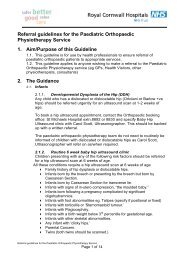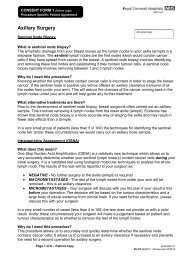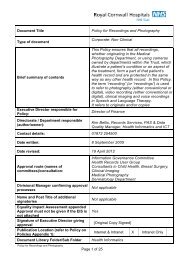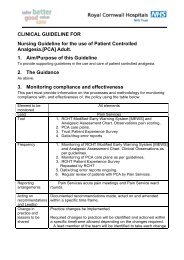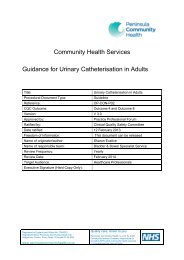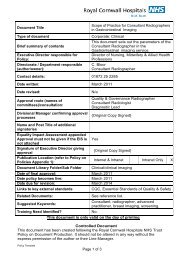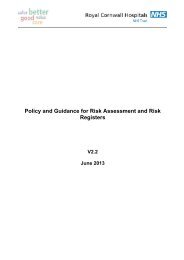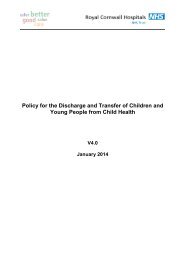Injectable Medicines Policy - the Royal Cornwall Hospitals Trust ...
Injectable Medicines Policy - the Royal Cornwall Hospitals Trust ...
Injectable Medicines Policy - the Royal Cornwall Hospitals Trust ...
You also want an ePaper? Increase the reach of your titles
YUMPU automatically turns print PDFs into web optimized ePapers that Google loves.
<strong>Injectable</strong> <strong>Medicines</strong> <strong>Policy</strong>V2.1August 2013
Table of Contents1. Introduction ................................................................................................................... 32. Purpose of this <strong>Policy</strong>/Procedure .................................................................................. 33. Scope ........................................................................................................................... 34. Definitions / Glossary .................................................................................................... 35. Ownership and Responsibilities .................................................................................... 35.1. Role of <strong>the</strong> Managers ............................................................................................ 36. Standards and Practice ................................................................................................ 46.1. Prescribing <strong>Injectable</strong> <strong>Medicines</strong> ........................................................................... 46.5. Preparation and Administration of <strong>Injectable</strong> <strong>Medicines</strong> ........................................ 46.15. Mixing of <strong>Medicines</strong> ........................................................................................... 56.23. Double Checking of <strong>Injectable</strong> <strong>Medicines</strong> .......................................................... 66.34. Training and Assessment of Competence ......................................................... 77. Dissemination and Implementation ............................................................................... 88. Monitoring compliance and effectiveness ..................................................................... 89. Updating and Review .................................................................................................... 910. Equality and Diversity ................................................................................................ 910.2. Equality Impact Assessment .............................................................................. 9Appendix 1. Governance Information ................................................................................ 10Appendix 2 – Standard Operating Procedure for Administering an <strong>Injectable</strong> Medicine .... 12Appendix 3. Initial Equality Impact Assessment Screening Form ...................................... 18<strong>Injectable</strong> <strong>Medicines</strong> <strong>Policy</strong>Page 2 of 19
5.6. Individual Staff will ensure that injectable medicines are prescribed, preparedand administered in line with this policy and <strong>the</strong> <strong>Medicines</strong> <strong>Policy</strong>.5.7. Individual staff are responsible for recording all incidences of non-compliancewith this policy, <strong>the</strong> <strong>Medicines</strong> <strong>Policy</strong> and clinical incidents involving injectablemedicines on <strong>the</strong> <strong>Trust</strong>’s incident management system (Datix)6. Standards and Practice6.1. Prescribing <strong>Injectable</strong> <strong>Medicines</strong>6.2. Refer to <strong>the</strong> <strong>Medicines</strong> <strong>Policy</strong> for general guidelines on prescribing.6.3. Where relevant, <strong>the</strong> prescription, or a readily available local protocol, mustspecify <strong>the</strong> following:• Generic name and formulation of <strong>the</strong> medicine (unless it is a medicine which isnot dose interchangeable in which case it should be prescribed by brand name)• Concentration or total quantity of medicine in <strong>the</strong> final infusion container orsyringe• Name and volume of dilutent and/or infusion fluid• Rate and duration of administration• Stability information to determine <strong>the</strong> expiry date of <strong>the</strong> final product• Type of rate-control pump or device(s) to be used• The age and weight of any patient under 16 years of age, where relevant• Date on which treatment should be reviewed• arrangements for fluid balance or clinical monitoring should be made on anindividual patient basis and according to local protocol and clinical need.6.4. Local protocols can be found on <strong>the</strong> document library. Where none exist pleaserefer to <strong>the</strong> protocols stated in <strong>the</strong> University College London (UCL) <strong>Injectable</strong><strong>Medicines</strong> Administration Guide, <strong>the</strong> BNF or <strong>the</strong> packaging used for <strong>the</strong> product.6.5. Preparation and Administration of <strong>Injectable</strong> <strong>Medicines</strong>6.6. Section 8 of The <strong>Medicines</strong> Act 1968 states that no person may manufacture orassemble any medicinal product except in accordance with a licence. However,sections 9, 10 and 11 of <strong>the</strong> <strong>Medicines</strong> Act provide exemptions to thisrestriction for registered doctors, pharmacists, nurse and midwives. As such, onlyregistered doctors, pharmacists, nurses and midwives are allowed to prepareinjectable medicines. Where nursing students are involve in preparation, thismust be under <strong>the</strong> direct supervision of a registered practitioner and <strong>the</strong> thispractitioner takes legal responsibility for <strong>the</strong> process6.7. Only registered nurses, midwives, Operating Department Practitioners (ODPs)and doctors are permitted to administer injectable medicines within <strong>the</strong> <strong>Trust</strong>.6.8. Radiographers may prepare and administer <strong>Medicines</strong> for intravenousadministration under <strong>the</strong> supervision or at <strong>the</strong> request of an anaes<strong>the</strong>tist, surgeon orradiologist.<strong>Injectable</strong> <strong>Medicines</strong> <strong>Policy</strong>Page 4 of 19
6.9. Nuclear Medicine technicians may administer pre-prepared IVradiopharmaceuticals under <strong>the</strong> licence, supervision and training of a namedConsultant Radiologist.6.10. Preparation and administration of injectable medicines must be carried out inaccordance with <strong>the</strong> Standard Operating Procedure for Administering an <strong>Injectable</strong>Medicine (Appendix 2) (See also ‘Mixing <strong>Medicines</strong> – Section 8 below)6.11. Under no circumstances should an injectable cytotoxic medicine be preparedor additions be made to cytotoxic medicines or TPN bags outside of <strong>the</strong> Pharmacy6.12. Technical Services Unit. The only exception to this is <strong>the</strong> use of dexrazoxane(Savene®) for cases of extravasation (see extravasation policy).6.13. Unregistered Healthcare workers (e.g. Health Care Assistants, AssistantPractitioners and student nurses) must not prepare or administer and injectablemedicine except boluses of Sodium Chloride 0.9% for <strong>the</strong> purposes of flushing newlyinserted cannulae once <strong>the</strong>y have been suitably trained and assessed as competentto do so. These may only be administered where a prescription for this item exists.This must also be checked by a registered Healthcare Professional who is competentat injectable drug administration. Subsequent flushing of cannulae must not beundertaken.6.14. Certain groups of medicines or administration routes may not beadministered/utilised by medical, nursing, midwifery or allied health professionalsexcept under certain circumstances as specified in <strong>the</strong> relevant policy. These are:• Cytotoxic drugs - see cytotoxic policy• Intra<strong>the</strong>cal drugs – see intra<strong>the</strong>cal policy• Patient controlled analgesia – see clinical guidelines• Epidurals and spinals – see clinical guidelines• Sedation – see Conscious Sedation <strong>Policy</strong>• Peripheral nerve blocks – see clinical guidelines6.15. Mixing of <strong>Medicines</strong>6.16. The mixing of medicines is defined as <strong>the</strong> ‘combination of two or moremedicinal products toge<strong>the</strong>r for <strong>the</strong> purposes of administering <strong>the</strong>m to meet <strong>the</strong>needs of a particular patient’. This includes <strong>the</strong> administration of more than oneintravenous drug where mixing takes place at a ‘Y’ site but does not include mixingwhere one product is a vehicle for <strong>the</strong> o<strong>the</strong>r.6.17. It is common practice in palliative care to combine medicines in a syringe driver.Administration of multiple medications which mix at a ‘Y’ site is also common practicein o<strong>the</strong>r areas of medicine and surgery.6.18. Compounding and mixing of medicines should, wherever possible, be carriedout in <strong>the</strong> pharmacy technical services unit. As per 7.5 above, certain groups ofmedicines should never be compounded or mixed in clinical areas. (Compounding isdefined as <strong>the</strong> mixing of 2 or more parts or ingredients to make a preparation foradministration).<strong>Injectable</strong> <strong>Medicines</strong> <strong>Policy</strong>Page 5 of 19
6.19. It is best practice to use a single lumen of an intravenous cannula to administereach medicine, which is <strong>the</strong>n flushed between each administration. However, this isnot always practical, due to <strong>the</strong> number of drugs or lack of intravenous access.6.20. Where medicines are compounded in established combinations or mixed at a‘Y’ site in clinical areas, this should be in accordance with standard procedures.6.21. Where a mixture is not usual practice, reference should be made to standardreference sources which include:• PCF4 Palliative Care Formulary 4 th ed, T wycross R, Wilcock A, RadcliffeMedical Press 2007 (http://www.palliativedrugs.com) Press 2005(http://www.pallcare.info)• Medusa IV Guide (http://medusa.wales.nhs.uk)• Referenced and evaluated reference charts such as used inAnaes<strong>the</strong>tics, Neonatology or Thames Valley ‘Y’ site intravenous drugscompatibility chart (accessed via Medusa)• UCL <strong>Injectable</strong> <strong>Medicines</strong> Administration Guide 3 rd edition 2010, Wiley -Blackwell6.22. In all o<strong>the</strong>r cases expert advice should be sought from <strong>the</strong> pharmacists.6.23. Double Checking of <strong>Injectable</strong> <strong>Medicines</strong>6.24. The <strong>Trust</strong> requires double checking for all injectable medicines administeredintravenously e.g. IV boluses and IV infusions, by registered doctors, nursing andODP staff.6.25. For injectable medicines administered by o<strong>the</strong>r routes, double checking is onlymandated in <strong>the</strong> following high risk situations:• Where <strong>the</strong> administering professional requests a second check• Where specified by ano<strong>the</strong>r policy (i.e. Intra<strong>the</strong>cal <strong>Policy</strong>, Cytotoxic <strong>Policy</strong>)• Subcutaneous syringe drivers for palliative care patients where it requires <strong>the</strong>mixing of two or more drugs• Where a complex calculation is required.• Where UCL <strong>Injectable</strong> <strong>Medicines</strong> Administration Guide 3rd edition indicates ahigh level of risk (NPSA risk rating of 6 or above)• Neonates and paediatric departments• All medicines encompassed by <strong>the</strong> 1971 Misuse of <strong>Medicines</strong> Act (i.e.Controlled Drugs)6.26. Undertaking <strong>the</strong> period of supervised practice as defined in <strong>the</strong> RCHT <strong>Injectable</strong><strong>Medicines</strong> Competency Framework.<strong>Injectable</strong> <strong>Medicines</strong> <strong>Policy</strong>Page 6 of 19
6.27. Any administration of an injectable medicine where double checking has notoccurred where it is required must be recorded on <strong>the</strong> <strong>Trust</strong>’s incident managementsystem so that <strong>the</strong> circumstances can be investigated and actions taken to preventfuture incidences.6.28. Where injectable medicines are double checked <strong>the</strong> checking practitioner mustbe a registered Doctor, nurse, OPP, midwife pharmacist or 3rd year nursing studentcompetent in <strong>the</strong> use of medicines. The double check is to confirm <strong>the</strong> correctpreparation of <strong>the</strong> correct drug and not to confirm <strong>the</strong> administration (except forControlled drugs- please refer to Controlled Drug <strong>Policy</strong> and ward SOP)6.29. Where injectable medicines are double checked by two registered practitionersor 3rd year student nurse, both must sign <strong>the</strong> administration record. Electronicadministration via <strong>the</strong> JAC system will request <strong>the</strong> password of <strong>the</strong> checker. On <strong>the</strong>paper drug charts, <strong>the</strong> administration box should be divided in two and <strong>the</strong> personadministering <strong>the</strong> drug should sign in <strong>the</strong> top half and <strong>the</strong> checker sign in <strong>the</strong> bottomhalf.6.30. All competent Registered Healthcare Professionals can check intravenousmedicines in accordance with <strong>the</strong> scope of <strong>the</strong>ir professional practice andregistration.6.31. Double checking of all IV medicines is recommended in <strong>the</strong>atre environment ifpossible. If however <strong>the</strong> patient is at risk if <strong>the</strong> drug is not administered in timelyfashion <strong>the</strong>n it is appropriate to give without having a second check. Anaes<strong>the</strong>tistsmust be aware of <strong>the</strong> increased risk of medication error where a second check is notobtained.6.32. In an emergency situation where a patient is at risk of being harmed ifadministration of a medication is delayed it is permissible to administer medicineswithout a double check.6.33. Areas challenged to comply with <strong>the</strong>se rules need to raise concerns through<strong>the</strong>ir divisional nurse or divisional director to <strong>the</strong> chief pharmacist. A risk assessmentwill need to be completed and acknowledged on <strong>the</strong> Divisional risk register andmitigating measures considered. A final decision for safe arrangements will be madeby <strong>the</strong> chief pharmacist supported by <strong>the</strong> Medication Practice Committee.6.34. Training and Assessment of Competence6.35. This relates to Medical and Nursing staff, Operating Department Practitioners,Radiographers and Nuclear Medicine staff.6.36. All of <strong>the</strong> staff groups mentioned in 10.1 must undergo injectable medicinetraining before administering injectable medicines and be assessed as beingcompetent to do so.6.37. Persons assessing competence must <strong>the</strong>mselves be competent in injectablemedicines administration.<strong>Injectable</strong> <strong>Medicines</strong> <strong>Policy</strong>Page 7 of 19
6.38. Newly qualified members of staff must undertake <strong>the</strong> approved <strong>Trust</strong> training forinjectable medicines. This does not apply to medical staff who have done this in <strong>the</strong>irtraining.6.39. Training for newly qualified nurses and ODPs will normally be undertaken within<strong>the</strong> first year of becoming qualified. Ensuring this is completed is <strong>the</strong> responsibility of<strong>the</strong> department manager who is also responsible for maintaining records of thistraining.6.40. Doctors who have previously undertaken injectable training and can evidencethis must be assessed as competent by ano<strong>the</strong>r IV competent individual before <strong>the</strong>ymay administer IV medications. Ensuring this is completed is <strong>the</strong> responsibility of <strong>the</strong>individual doctor who is also responsible for maintaining records of this training.6.41. Doctors who have not previously undertaken IV training must do <strong>Trust</strong> training.6.42. Nursing staff and ODPs appointed from outside of <strong>the</strong> <strong>Trust</strong> who regularly gaveIV drugs in <strong>the</strong>ir last post must do <strong>the</strong> following:• Show evidence of <strong>the</strong>ir competence from previous training and evidence ofrecent updating• Read this policy and Appendix 2 as well as <strong>the</strong> <strong>Trust</strong>’s <strong>Medicines</strong> <strong>Policy</strong>• Complete mandatory Aseptic Non-Touch Technique (ANTT) training• Have <strong>the</strong>ir practice observed by someone nominated by <strong>the</strong>ir manager who iscompetent in this area6.43. This removes <strong>the</strong> need to do <strong>the</strong> <strong>Trust</strong> in house training. If <strong>the</strong> evidence is notavailable, staff must undertake <strong>the</strong> <strong>Trust</strong> approved training for <strong>the</strong> administration of IV<strong>Medicines</strong> and assessment of competence.6.44. All staff giving injectable medicines need to undertake ANTT as part of <strong>the</strong>irmandatory training and injectable medicines mandatory training every year. Aregular assessment of injectable medicines competence (by observation by acompetent IV administrator) must be carried out by all staff and records of thisassessment be maintained as part of <strong>the</strong> persons PDR process.7. Dissemination and Implementation7.1. The document is available on <strong>the</strong> <strong>Trust</strong>'s Document Library. Significantupdates will be communicated via <strong>Trust</strong>-wide email.7.2. Implementation of <strong>the</strong> policy will be via <strong>Trust</strong>-wide communication andsupported by appropriate training for <strong>the</strong> relevant members of staff.7.3. Training for this policy will be as set out in <strong>the</strong> medicines management sectionof core training matrix of <strong>the</strong> <strong>Trust</strong> Core Training <strong>Policy</strong>.8. Monitoring compliance and effectivenessElement to bemonitored<strong>Injectable</strong> <strong>Medicines</strong> <strong>Policy</strong>The prescribing, preparation and administration of injectable medicinesPage 8 of 19
LeadToolFrequencyReportingarrangementsActing onrecommendationsand Lead(s)Change inpractice andlessons to besharedThe Lead Pharmacist for Medication SafetyThe NPSA tool for injectable medicines SABs alert will be used Datixfor clinical incidentsThe policy will be monitored every 2 years or sooner as clinicalincidents dictate.The audit results will be reported to <strong>the</strong> Medication PracticeCommittee (MPC) and to <strong>the</strong> individual areas audited.Clinical Incidents on Datix will be reported to <strong>the</strong> seniornurse/manager in that area and will also be reported to <strong>the</strong> MedicationSafety GroupThe MPC will co-ordinate <strong>the</strong> actions to <strong>the</strong> audit results.Actions from <strong>the</strong> incident reports will be at a local level and may alsoresult in broader actions, co-ordinated by <strong>the</strong> Medication Safety Group.Required changes to practice will be identified and actioned within <strong>the</strong>time frame specified in <strong>the</strong> action plan.9. Updating and Review9.1. This policy will be reviewed every 3 years or sooner in <strong>the</strong> light of changes inlegislation or practice. The policy review will be ratified by <strong>the</strong> Medication PracticeCommittee when changes are substantial. For minor changes <strong>the</strong> chair of <strong>the</strong>Medication Practice Committee can approve and re-publish.10. Equality and Diversity10.1. This document complies with <strong>the</strong> <strong>Royal</strong> <strong>Cornwall</strong> <strong>Hospitals</strong> NHS <strong>Trust</strong> serviceEquality and Diversity statement.10.2. Equality Impact Assessment10.3. The Initial Equality Impact Assessment Screening Form is at Appendix 3.<strong>Injectable</strong> <strong>Medicines</strong> <strong>Policy</strong>Page 9 of 19
Appendix 1. Governance InformationDocument TitleDate Issued/Approved: 8 th August 2013<strong>Injectable</strong> <strong>Medicines</strong> <strong>Policy</strong> (incorporatingStandard Operating Procedure for Prescribing,Preparing and Administering <strong>Injectable</strong><strong>Medicines</strong> in Clinical Areas)Date Valid From: 8 th August 2013Date Valid To: 1 st August 2016Directorate / Departmentresponsible (author/owner):Pharmacy Department, Chief PharmacistContact details: 01872 252593Brief summary of contentsDescribed safe and legally compliant methods for<strong>the</strong> prescribing, preparation and administration ofinjectable medicines within clinical settings.Suggested Keywords:Target AudienceExecutive Director responsible for<strong>Policy</strong>:.<strong>Injectable</strong> <strong>Medicines</strong> <strong>Policy</strong>RCHT PCH CFT KCCG Medical DirectorDate revised: August 2013This document replaces (exact titleof previous version):Approval route (names ofcommittees)/consultation:Standard Operating Procedure for Prescribing,Preparing and Administering <strong>Injectable</strong><strong>Medicines</strong> in Clinical Areas)Medication Practice CommitteeDivisional Manager confirmingapproval processesBruce DanielName and Post Title of additionalsignatoriesSignature of Executive Directorgiving approvalPublication Location (refer to <strong>Policy</strong>on Policies – Approvals andRatification):Document Library Folder/SubFolderLinks to key external standardsRelated Documents:<strong>Injectable</strong> <strong>Medicines</strong> <strong>Policy</strong>n/a{Original Copy Signed}Internet &IntranetPage 10 of 19IntranetOnlyPharmacy, injectable, injection, intravenous,subcutaneous, intramuscular, IV.CQC Outcome 9- <strong>Medicines</strong> Management20 - Promoting Safer Use of <strong>Injectable</strong>
Training Need Identified?<strong>Medicines</strong>, 28th March 2007The <strong>Medicines</strong> <strong>Policy</strong>The University College London (UCL)<strong>Injectable</strong> Medicine Administration GuideBritish National Formulary (BNF)Aseptic Non-touch TechniqueStandards for <strong>Medicines</strong> Management -Nursing and Midwifery Council Intra<strong>the</strong>cal<strong>Policy</strong>Cytotoxic <strong>Policy</strong> Extravasation <strong>Policy</strong> LoadingDose WorksheetsYesVersion Control TableDateOctober2008Version NoV 1.0Initial IssueSummary of ChangesChanges Made by(Name and Job Title)Stephen ThomasHead of PharmacyTechnical ServicesJune 2011 V 1.2Review with minor amendments andreformatted into <strong>Trust</strong> <strong>Policy</strong> formatIain DavidsonChief PharmacistMarch2012V2Change from SOP into <strong>Injectable</strong> <strong>Medicines</strong><strong>Policy</strong> with old policy contents as an appendixIan NichollsMedication SafetyLead PharmacistJuly 2013 V 2.1<strong>Policy</strong> updated to clarify arrangements for <strong>the</strong>double checking of injectable medicinesIain DavidsonChief PharmacistAll or part of this document can be released under <strong>the</strong> Freedom of InformationAct 2000This document is to be retained for 10 years from <strong>the</strong> date of expiry.This document is only valid on <strong>the</strong> day of printingControlled DocumentThis document has been created following <strong>the</strong> <strong>Royal</strong> <strong>Cornwall</strong> <strong>Hospitals</strong> NHS <strong>Trust</strong><strong>Policy</strong> on Document Production. It should not be altered in any way without <strong>the</strong>express permission of <strong>the</strong> author or <strong>the</strong>ir Line Manager.<strong>Injectable</strong> <strong>Medicines</strong> <strong>Policy</strong>Page 11 of 19
Appendix 2 – Standard Operating Procedure for Administeringan <strong>Injectable</strong> MedicineThis appendix is based on <strong>the</strong> ‘Template Standard Operating Procedure for Use of<strong>Injectable</strong> <strong>Medicines</strong>’ published by <strong>the</strong> National Patient Safety Agency (NPSA) in March2007 as part of its ‘Patient Safety Alert 20, Promoting Safer Use of <strong>Injectable</strong> <strong>Medicines</strong>’.1. Preparation1.1 Read all prescription details carefully and confirm that <strong>the</strong>y relate to <strong>the</strong> patient tobe treated.1.2 Ensure that <strong>the</strong> area in which <strong>the</strong> medicine is to be prepared is as clean,uncluttered and free from interruption and distraction as possible. Ideally, preparationshould take place in an area dedicated to this process. (NB High risk if not compliant).1.3 Assemble all materials and equipment: sharps bin for waste disposal,medicine ampoule(s)/vial(s), diluent, syringe(s), needle(s), alcohol wipe(s), disposableprotective gloves, clean re-usable plastic tray, disposable plastic apron.1.4 Check <strong>the</strong> following:<strong>Injectable</strong> <strong>Medicines</strong> <strong>Policy</strong>expiry dates on medicinesdamage to containers, vials or packagingthat medicines were stored as recommended, e.g. in <strong>the</strong> refrigerator.1.5 Beware of <strong>the</strong> risk of confusion between similar looking medicine packs, namesand strengths. Read all labels carefully.1.6 Check that:<strong>the</strong> formulation, dose, diluent, infusion fluid and rate ofadministration correspond to <strong>the</strong> prescription and product information<strong>the</strong> patient has no known allergy to <strong>the</strong> medicineyou understand <strong>the</strong> method of preparation. Use <strong>the</strong> University CollegeLondon (UCL) <strong>Injectable</strong> Medicine Administration Guide, British National Formulary(BNF) or drug package insert for guidance.1.7 Calculate <strong>the</strong> volume of medicine solution needed to give <strong>the</strong> prescribed dose.Write <strong>the</strong> calculation down and obtain an independent check by ano<strong>the</strong>r qualifiedhealthcare professional.1.8 Prepare <strong>the</strong> label for <strong>the</strong> prepared medicine (see section 7).1.9 Cleanse your hands according to local policy.1.10 Put on a pair of disposable protective gloves.1.11 Use a 70% alcohol wipe or spray to disinfect <strong>the</strong> surface of <strong>the</strong> plastic tray.1.12 Assemble <strong>the</strong> syringe(s) and needle(s). Peel open wrappers carefully andarrange all ampoules/vials, syringes and needles neatly in <strong>the</strong> tray.1.13 Use a ‘non-touch’ technique throughout, i.e. avoid touching areas wherebacterial contamination may be introduced, e.g. syringe-tips, needles, vial tops. Neverput down a syringe attached to an unshea<strong>the</strong>d needle.1.14 Prepare <strong>the</strong> injection by following <strong>the</strong> manufacturer’s product information orlocal guidelines, and <strong>the</strong> relevant guidance in sections 2 to 102. Withdrawing solution from an ampoule (glass or plastic) into a syringePage 12 of 19
2.1 Tap <strong>the</strong> ampoule gently to dislodge any medicine in <strong>the</strong> neck.2.2 Wipe neck of ampoule with alcohol wipe and allow to dry for 30 seconds.2.3 Attach a needle to a syringe.2.4 Snap open <strong>the</strong> neck of glass ampoules, using an ampoule snapper if required.2.5 Using <strong>the</strong> syringe and needle, draw <strong>the</strong> required volume of solution into <strong>the</strong> syringe.Tilt <strong>the</strong> ampoule if necessary. Consider using a filter needle or filter straw to avoid drawingup glass particles into <strong>the</strong> syringe.2.6 Hold <strong>the</strong> syringe vertically and tap lightly to aggregate <strong>the</strong> air bubbles at <strong>the</strong>needle end. Expel <strong>the</strong> air carefully.2.7 Remove <strong>the</strong> needle from <strong>the</strong> syringe and fit a new needle or sterile blind hub.2.8 Label <strong>the</strong> syringe (see section 7).2.9 Keep <strong>the</strong> ampoule and any unused medicine until administration to <strong>the</strong> patientis complete to enable fur<strong>the</strong>r checking procedures to be undertaken.2.10 If <strong>the</strong> ampoule contains a suspension ra<strong>the</strong>r than solution, it should begently swirled to mix <strong>the</strong> contents immediately before <strong>the</strong>y are drawn into <strong>the</strong> syringe.2.11 The neck of some plastic ampoules is designed to connect directly to asyringe without use of a needle after <strong>the</strong> top of <strong>the</strong> ampoule has been wiped with analcohol wipe, allowed to dry and twisted off.3 Withdrawing a solution or suspension from a vial into a syringe3.1 Remove <strong>the</strong> tamper-evident seal from <strong>the</strong> vial and wipe <strong>the</strong> rubber septum withan alcohol wipe. Allow to dry for at least 30 seconds.3.2 With <strong>the</strong> needle shea<strong>the</strong>d, draw into <strong>the</strong> syringe a volume of air equivalent to<strong>the</strong> required volume of solution to be drawn up.3.3 Remove <strong>the</strong> needle cover and insert <strong>the</strong> needle into <strong>the</strong> vial through <strong>the</strong>rubber septum.3.4 Invert <strong>the</strong> vial. Keep <strong>the</strong> needle in <strong>the</strong> solution and slowly depress <strong>the</strong> plunger topush air into <strong>the</strong> vial.3.5 Release <strong>the</strong> plunger so that solution flows back into <strong>the</strong> syringe.3.6 If a large volume of solution is to be withdrawn, use a push-pull technique.Repeatedly inject small volumes of air and draw up an equal volume of solution until <strong>the</strong>required total is reached. This ‘equilibrium method’ helps to minimise <strong>the</strong> build-up ofpressure in <strong>the</strong> vial.3.7 Alternatively, <strong>the</strong> rubber septum may be pierced with a second needle to let air into<strong>the</strong> vial as solution is withdrawn. The tip of <strong>the</strong> vent needle must always be kept above <strong>the</strong>solution to prevent leakage.3.8 With <strong>the</strong> vial still attached, invert <strong>the</strong> syringe. With <strong>the</strong> needle and vial uppermost,tap <strong>the</strong> syringe lightly to aggregate <strong>the</strong> air bubbles at <strong>the</strong> needle end. Push <strong>the</strong> air backinto <strong>the</strong> vial. If a vent needle used, ensure <strong>the</strong> tip of <strong>the</strong> vent needle is located within <strong>the</strong>air space within <strong>the</strong> vial3.9 Fill <strong>the</strong> syringe with <strong>the</strong> required volume of solution. Withdraw <strong>the</strong> needle from <strong>the</strong> vial.3.10 Check correct volume is contained in syringe. Remove <strong>the</strong> needle and exchangeit for a new needle or a sterile blind hub.<strong>Injectable</strong> <strong>Medicines</strong> <strong>Policy</strong>Page 13 of 19
3.11 The vial(s) and any unused medicine should be kept until administration to<strong>the</strong> patient is complete.3.12 If <strong>the</strong> vial contains a suspension ra<strong>the</strong>r than solution, it should be gently swirledto mix <strong>the</strong> contents, immediately before <strong>the</strong>y are drawn into <strong>the</strong> syringe.4 Reconstituting powder in a vial and drawing <strong>the</strong> resulting solutionor suspension into a syringe4.1 Remove <strong>the</strong> tamper-evident seal from <strong>the</strong> vial and wipe <strong>the</strong> rubber septum withan alcohol wipe. Allow to dry for at least 30 seconds.4.2 Use <strong>the</strong> procedure in 4.2 above to withdraw <strong>the</strong> required volume of diluent (e.g.water for injections, sodium chloride 0.9% or manufacturers supplied diluent),from ampoule(s) into <strong>the</strong> syringe.4.3 Inject <strong>the</strong> diluent into <strong>the</strong> vial. Keeping <strong>the</strong> tip of <strong>the</strong> needle above <strong>the</strong> level of<strong>the</strong> solution in <strong>the</strong> vial, release <strong>the</strong> plunger. The syringe will fill with <strong>the</strong> air which has beendisplaced by <strong>the</strong> solution (if <strong>the</strong> contents of <strong>the</strong> vial were packed under a vacuum, solutionwill be drawn into <strong>the</strong> vial and no air will be displaced). If a large volume of diluent is to beadded, use a push-pull technique.4.4 With <strong>the</strong> syringe and needle still in place, and if permitted by <strong>the</strong>manufacturer's literature, gently swirl <strong>the</strong> vial(s) to dissolve all <strong>the</strong> powder. This may takeseveral minutes.4.5 Follow <strong>the</strong> relevant steps in section 2 above to withdraw <strong>the</strong> required volumeof solution from <strong>the</strong> vial into <strong>the</strong> syringe.4.6 If a purpose-designed reconstitution device is used, <strong>the</strong> manufacturer’sinstructions should be read carefully and followed closely.5 Adding a medicine to an infusion5.1 Prepare <strong>the</strong> medicine in a syringe using one of <strong>the</strong> methods described in section 2above.5.2 Check <strong>the</strong> outer wrapper of <strong>the</strong> infusion container is undamaged.5.3 Remove <strong>the</strong> wrapper and check <strong>the</strong> infusion container itself in good light. It shouldbe intact and free of cracks, punctures and leaks.5.4 Check <strong>the</strong> infusion solution, which should be free of haziness, particlesand discolouration. NB The plastic on some infusion bags can sometimes appear hazy.5.5 Where necessary, remove <strong>the</strong> tamper-evident seal on <strong>the</strong> additive port according to<strong>the</strong> manufacturer’s instructions or wipe <strong>the</strong> rubber septum on <strong>the</strong> infusion container withan alcohol wipe and allow to dry for at least 30 seconds.5.6 If <strong>the</strong> volume of medicine solution to be added is more than 10% of <strong>the</strong> initialcontents of <strong>the</strong> infusion container (more than 50ml to a 500ml or 100ml to a 1litreinfusion), an equivalent volume must first be removed with a syringe and needle.5.7 Inject <strong>the</strong> medicine into <strong>the</strong> infusion container through <strong>the</strong> centre of <strong>the</strong> injectionport, taking care to keep <strong>the</strong> tip of <strong>the</strong> needle away from <strong>the</strong> side of <strong>the</strong> infusion container.Withdraw <strong>the</strong> needle and gently invert <strong>the</strong> container at least ten times to ensure thoroughmixing before starting <strong>the</strong> infusion.5.8 Do not add anything to any infusion container o<strong>the</strong>r than a burette when it ishanging on <strong>the</strong> infusion stand since this makes adequate mixing impossible.<strong>Injectable</strong> <strong>Medicines</strong> <strong>Policy</strong>Page 14 of 19
5.9 Before adding a medicine to a hanging burette, administration must be stopped.After <strong>the</strong> addition has been made and before administration is re-started, <strong>the</strong> contents of<strong>the</strong> burette must be carefully swirled to ensure complete mixing of <strong>the</strong> contents.5.10 Check <strong>the</strong> appearance of <strong>the</strong> final infusion for absence of particles, cloudinessor discolouration.5.11 Label <strong>the</strong> infusion (see section 7).6 Diluting a medicine in a syringe for use in a pump or syringe-driver6.1 Prepare <strong>the</strong> medicine in a syringe using one of <strong>the</strong> methods described above.6.2 Draw <strong>the</strong> diluent into <strong>the</strong> syringe to be used for administration by <strong>the</strong> pump orsyringe- driver. Draw in some air (slightly more than <strong>the</strong> volume of medicineneeded) and remove <strong>the</strong> needle.6.3 Stand <strong>the</strong> diluent syringe upright. Insert <strong>the</strong> needle of <strong>the</strong> syringe containing<strong>the</strong> medicine into <strong>the</strong> tip of <strong>the</strong> diluent (administration) syringe and add <strong>the</strong> medicine to it.Alternatively, a disposable sterile connector may be used to directly connect two syringestoge<strong>the</strong>r.6.4 Fit a blind hub to <strong>the</strong> administration syringe and invert several times to mix<strong>the</strong> contents.6.5 Tap <strong>the</strong> syringe lightly to aggregate <strong>the</strong> air bubbles at <strong>the</strong> needle end. Remove<strong>the</strong> blind hub. Expel <strong>the</strong> air and refit <strong>the</strong> blind hub.6.6 Carefully check <strong>the</strong> syringe for cracks and leaks and <strong>the</strong>n label it (seesection.7), especially noting <strong>the</strong> requirements specific to syringe drivers.6.7 Check <strong>the</strong> following:<strong>the</strong> total volume of injection solution in <strong>the</strong> syringe is as specified in<strong>the</strong> prescription and that <strong>the</strong> infusion can be delivered at <strong>the</strong> prescribed rate by <strong>the</strong>administration device chosen<strong>the</strong> rate of administration is set correctly on <strong>the</strong> administration deviceand according to <strong>the</strong> manufacturer’s instructions.6.8 Check that <strong>the</strong> rate of administration is set correctly on <strong>the</strong> device before fitting<strong>the</strong> syringe, priming <strong>the</strong> administration set and starting <strong>the</strong> infusion device.7 Labelling injection and infusion containers7.1 All injections should be labelled immediately after preparation, except forsyringes intended for immediate push (bolus) administration by <strong>the</strong> person who prepared<strong>the</strong>m. Under no circumstances should an operator be in possession of more than oneunlabelled syringe at any one time, nor must an unlabelled syringe be fitted to a syringedriver or similar device.7.2 Labels used on injectable medicines prepared in clinical areas should contain<strong>the</strong> following information:Name of <strong>the</strong> medicineStrengthRoute of administrationDiluent and final volumePatient’s nameExpiry date and time<strong>Injectable</strong> <strong>Medicines</strong> <strong>Policy</strong>Page 15 of 19
Name of <strong>the</strong> practitioner preparing <strong>the</strong> medicine.7.3 Place <strong>the</strong> final syringe or infusion and <strong>the</strong> empty ampoule(s)/vials(s) in a cleanplastic tray with <strong>the</strong> prescription for taking to <strong>the</strong> patient for administration.8 Administration of an injectable medicine8.1 Before administering any injection refer to <strong>the</strong> administration section in The <strong>Medicines</strong><strong>Policy</strong>8.2 Also check, where relevant:orBrand name and formulation of <strong>the</strong> medicineConcentration or total quantity of medicine in <strong>the</strong> final infusion containersyringeName and volume of diluent and/or infusion fluidRate and duration of administrationType of rate-control pump or device(s) to be usedThe age and weight of any patient under 16 years of age, where relevantDate on which treatment should be reviewed.8.3 Check that <strong>the</strong> medicine is due for administration at that time and has not alreadybeen given.8.4 Assemble everything you need including any flushing solution(s) needed.8.5 Explain and discuss <strong>the</strong> procedure with <strong>the</strong> patient.8.6 Check any infusion already in progress. It should be free of haziness, particlesand discolouration.8.7 Check that an appropriate access device is in place. Flush it immediately beforeand after administration of a medicine, and between doses of different medicinesadministered consecutively, according to local policy. Also check <strong>the</strong> administration sitefor signs of leakage, infection or inflammation.9. Administration of injections – general9.1 Check infusions. They should be should be free of haziness, particlesand discolouration.9.2 Use aseptic (non-touch) techniques at all times.9.3 Attach administration sets to infusion containers carefully, on a flat surface andusing <strong>the</strong> technique appropriate to <strong>the</strong> type of container.9.4 Prime <strong>the</strong> access device according to local policy immediately before startingan infusion.9.5 Before adding a medicine to a hanging burette, administration must be stopped.After <strong>the</strong> addition has been made and before re-commencement, <strong>the</strong> contents of <strong>the</strong>burette must be carefully swirled to ensure complete mixing.9.6 If <strong>the</strong> medicine is a suspension in a syringe, gently roll <strong>the</strong> syringe between <strong>the</strong>palms of <strong>the</strong> hands to re-suspend <strong>the</strong> medicine, and administer immediately.10 After administration10.1 After completion of an intermittent infusion, flush <strong>the</strong> access device accordingto local policy.<strong>Injectable</strong> <strong>Medicines</strong> <strong>Policy</strong>Page 16 of 19
10.2 Ask <strong>the</strong> patient to report promptly any soreness at <strong>the</strong> injection site or discomfortof any sort.10.3 Make a detailed record of administration immediately after administering <strong>the</strong>medicine.10.4 Discard <strong>the</strong> empty ampoules/vials from which <strong>the</strong> injection was prepared andany unused medicine. Ampoules or vials should never be used to prepare more than oneinjection unless specifically labelled by <strong>the</strong> manufacturer for ‘multi-dose’ use.10.5 Re-check <strong>the</strong> administration site for signs of leakage, infection or inflammationand continue to monitor <strong>the</strong> patient, contents of <strong>the</strong> infusion container and <strong>the</strong> rateof infusion according to local policy.10.6 Check that arrangements for monitoring fluid balance or clinical parametershave been made. Ensure that relevant documentation is made available forsubsequent regular monitoring to take place.<strong>Injectable</strong> <strong>Medicines</strong> <strong>Policy</strong>Page 17 of 19
Appendix 3. Initial Equality Impact Assessment ScreeningFormName of service, strategy, policy or project (hereafter referred to as policy) to beassessed: Transfer of patients to and from JAC Electronic Prescribing and <strong>Medicines</strong>Administration / non- JAC Electronic Prescribing and <strong>Medicines</strong> Administration clinicallocationsDirectorate and service area: Pharmacy Is this a new or existing Procedure? NewName of individual completingTelephone: 2593assessment: Iain Davidson1. <strong>Policy</strong> Aim* To set out <strong>the</strong> process for patients transferring betweenelectronica prescribing and non-electronic prescribingenvironments2. <strong>Policy</strong> Objectives* To ensure patient safety at <strong>the</strong> point of transfer3. <strong>Policy</strong> – intendedOutcomes*4. How will you measure<strong>the</strong> outcome?5. Who is intended tobenefit from <strong>the</strong> <strong>Policy</strong>?No medication incidents due to patients transferring between<strong>the</strong> two EPMA/ non-EPMA environmentsdatixesPatients6a. Is consultationrequired with <strong>the</strong>workforce, equalitygroups, local interestgroups etc. around thispolicy?nob. If yes, have <strong>the</strong>segroups been consulted?c. Please list any groupswho have been consultedabout this procedure.*Please see Glossary7. The ImpactPlease complete <strong>the</strong> following table using ticks. You should refer to <strong>the</strong> EA guidance notesfor areas of possible impact and also <strong>the</strong> Glossary if needed.Where you think that <strong>the</strong> policy could have a positive impact on any of <strong>the</strong> equalitygroup(s) like promoting equality and equal opportunities or improving relationswithin equality groups, tick <strong>the</strong> ‘Positive impact’ box.Where you think that <strong>the</strong> policy could have a negative impact on any of <strong>the</strong> equalitygroup(s) i.e. it could disadvantage <strong>the</strong>m, tick <strong>the</strong> ‘Negative impact’ box.Where you think that <strong>the</strong> policy has no impact on any of <strong>the</strong> equality group(s) listedbelow i.e. it has no effect currently on equality groups, tick <strong>the</strong> ‘No impact’ box.<strong>Injectable</strong> <strong>Medicines</strong> <strong>Policy</strong>Page 18 of 19
EqualityGroupAgePositiveImpactNegativeImpactNoImpactXReasons for decisionDisabilityXReligion orbeliefXGenderXTransgenderXPregnancy/MaternityRaceXXSexualOrientationXMarriage / CivilPartnershipXYou will need to continue to a full Equality Impact Assessment if <strong>the</strong> following havebeen highlighted:A negative impact andNo consultation (this excludes any policies which have been identified as notrequiring consultation).8. If <strong>the</strong>re is no evidence that <strong>the</strong> policypromotes equality, equal opportunitiesor improved relations - could it beadapted so that it does? How?Full statement of commitment to policy ofequal opportunities is included in <strong>the</strong> policyPlease sign and date this form.Keep one copy and send a copy to Matron, Equality, Diversity and Human Rights,c/o <strong>Royal</strong> <strong>Cornwall</strong> <strong>Hospitals</strong> NHS <strong>Trust</strong>, Human Resources Department, ChyveanHouse, Penventinnie Lane, Truro, <strong>Cornwall</strong>, TR1 3LJA summary of <strong>the</strong> results will be published on <strong>the</strong> <strong>Trust</strong>’s web site.Signed _____Iain Davidson__________Date ______07/08/13_____________________<strong>Injectable</strong> <strong>Medicines</strong> <strong>Policy</strong>Page 19 of 19




